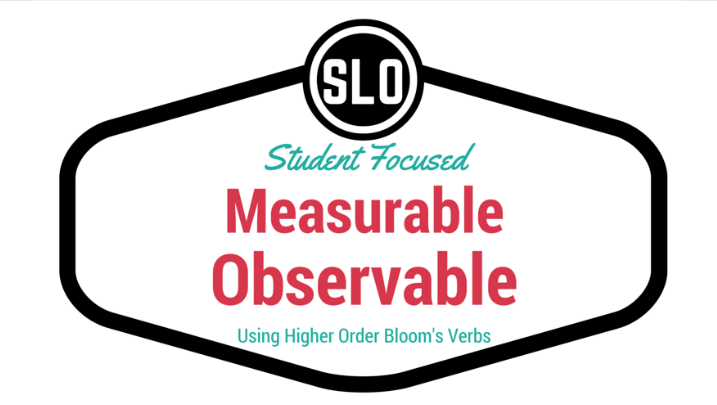[et_pb_section bb_built=”1″][et_pb_row][et_pb_column type=”4_4″][et_pb_text _builder_version=”3.21.4″ z_index_tablet=”500″]
What is the purpose of Student Learning Outcomes?
SLOs help us, faculty/program/ department/school, to determine and define what we want the learners to be able to DO, KNOW, & VALUE as a result of taking the course AND helps us design, evaluate and redesign the instruction for the future. These SLOs are an important component of course creation.
SLOs should be:
- Student focused
- Measurable and Observable
- Contain a verb from the upper levels of the Revised Bloom’s Taxonomy
[/et_pb_text][et_pb_text _builder_version=”3.21.4″ border_radii=”on|5px|5px|5px|5px” border_width_all=”1px” border_color_all=”#0c71c3″ z_index_tablet=”500″ custom_padding=”10px|10px|10px|10px”]
What do students really need to get out of your class?
When writing an SLO, one of the most difficult parts is making them measurable. The first step in this process is to
identify what the student NEEDS to know/value/be able to do.
Stay focused on the knowledge or skills they will need to retain to be successful in later classes, in the profession, and/or in life.
“I want students to …”
I want teacher candidates to …”
[/et_pb_text][et_pb_text _builder_version=”3.21.4″ z_index_tablet=”500″]
How to write an SLO
Step 1: What do students really need to get out of this class? (know, do, value)
Step 2: What performances, if achieved, would cause you to agree that students know it, can do it, or value it?
Step 3: For each performance, describe the quality or quantity you will consider acceptable to show they have achieved it.
Step 4: Test your performances. Ask yourself, if a student completed exactly what is outlined in Step 2 & 3, would I consider them to have completed the outcome listed in Step 1?
Step 5: Write S.M.A.R.T. Learning Outcomes (SLOs)
[/et_pb_text][/et_pb_column][/et_pb_row][et_pb_row][et_pb_column type=”1_2″][et_pb_text _builder_version=”3.21.4″ z_index_tablet=”500″]
SMART outcomes are set with the purpose of increasing student achievement. They are specific in that they clarify precisely what students should learn, the level of the learning (proficiency level), the assessments that will be used to make the proficiency determination and a time frame. A SMART Outcome is:
Specific ‐ A specific SLO has a much greater chance of being accomplished than a general one. To set a specific outcome you must answer the “W” questions:
- Who: Who is involved?
- What: What do I want to accomplish? (USE BLOOM’S VERBS!)
- When: Establish a time frame.
- Which: Identify requirements and constraints.
- Why: Specific reasons, purpose or benefits of accomplishing the outcome.
from UMass Dartmouth http://www.umassd.edu/fycm/goalsetting/resources/smartgoals/
Measurable ‐ Student success is measured by assessment. It answers the question – HOW, How much? How many? The criteria should be concrete and geared toward measuring progress.
Answer the question, “How will I know they’ve accomplished what I expect them to in this course?”
[/et_pb_text][/et_pb_column][et_pb_column type=”1_2″][et_pb_text _builder_version=”3.21.4″ z_index_tablet=”500″]
Attainable but Aggressive ‐ The outcome should be set high but within reason. High outcomes are not always attained but that does not mean it was a failure.
Results Oriented/Relevant ‐ Results tell you who has achieved proficiency. These results determine which students need remediation or enrichment. Relevant allows you to narrow the outcomes into those that are most important instead of trying measure everything in the course which can often happen.
Time Bound – All outcomes are bound by a clearly‐defined time frame. Setting a time lends a sense of urgency and allows you benchmarks by which you can examine your data and make relevant changes to move you and your students toward the final outcome.
[/et_pb_text][et_pb_image _builder_version=”3.21.4″ src=”https://blogs.cofc.edu/tlt/files/2019/08/Screen-Shot-2019-08-20-at-8.47.06-AM.png” z_index_tablet=”500″ /][/et_pb_column][/et_pb_row][et_pb_row][et_pb_column type=”4_4″][et_pb_text _builder_version=”3.21.4″ custom_padding=”10px|10px|10px|10px” border_radii=”on|5px|5px|5px|5px” border_width_all=”2px” border_color_all=”#0c71c3″ box_shadow_style=”preset2″ z_index_tablet=”500″]
Examples of SLOs
MODEL: As a result of WHAT, WHO will be able to ACTION VERB + DEFINED BY EXPLICIT AND OBSERVABLE TERMS.
As a result of PARTICIPATING IN THIS EXSC 315, STUDENTS will be able to ANALYZE AND SUMMARIZE a research study as using concise and non-judgemental language.
As a result of passing TEDU 201, the student will be able to debate major political and economic issues that have influenced policy decisions in education as determined by federal, state, and local agencies.
[/et_pb_text][et_pb_image _builder_version=”3.21.4″ z_index_tablet=”500″ /][/et_pb_column][/et_pb_row][/et_pb_section]

